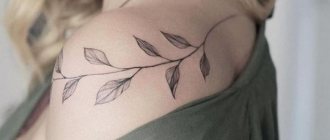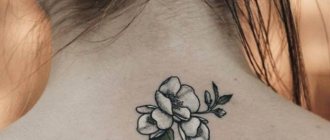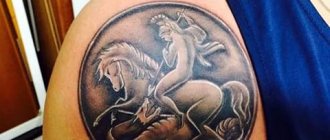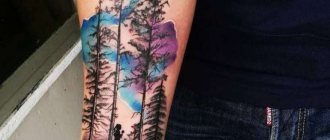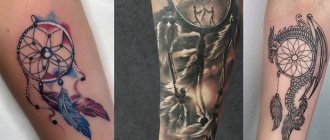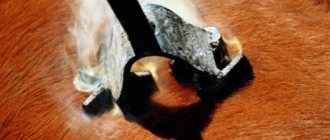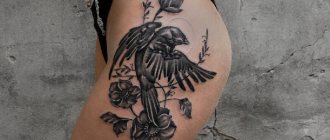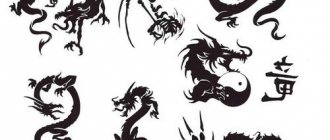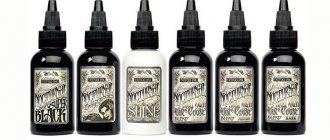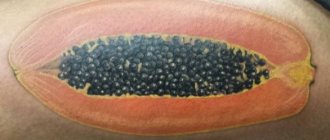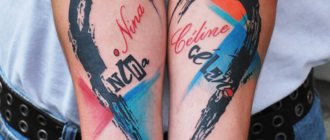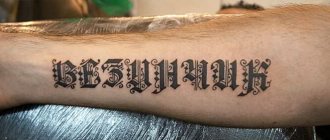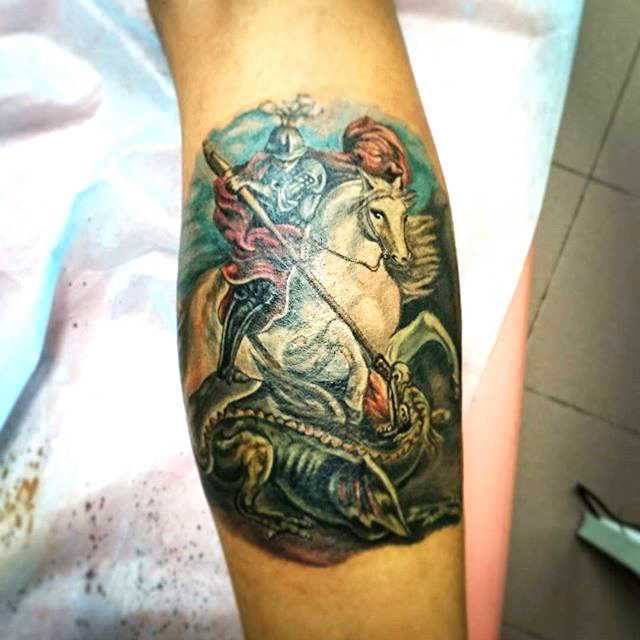
Tattoo of Saint George the Victorious, photo by:
St. George the Victorious is one of the famous great martyr saints in Christianity. There is no single interpretation of his life. In canonical writing, he was persecuted during the reign of Emperor Diocletian and was executed in 303. "The Miracle of the Serpent" is the best known account of his noble deeds. In the tale, George killed the serpent who demanded the emperor's daughter as a sacrifice.
History
George the Victorious is known in many cultures. Greek tales, Latin and Oriental texts speak of his exploits. In times of persecution, George is said to have defended his right to be a Christian and was tortured for seven days. For this endurance, God rewarded him with the gift of raising and reviving the dead, as well as the ability to heal himself. But the most famous miracle of the Great Martyr is the killing with his spear of the terrible dragon (or according to other legends, the serpent) that ravaged the land and demanded that the king's beautiful daughter be torn apart. In Christianity, this legend is interpreted as a victory over paganism (Christian faith is symbolized by the princess, and the pagan horrible dragon), or, according to other texts, the victory over the Devil the Tempter.
The meaning of the symbol
St. George the Victorious is a Christian symbol. He represents victory over evil. The most popular subject of the tattoo with Victory Bearer, is the image of the moment when he kills the serpent. George is a strong, brave and honest warrior of Russia. The meaning of the symbol, abstractly, can be formulated as follows:
- fearlessness,
- courage,
- military valor,
- strength of spirit,
- honesty.
The main purpose of such a tattoo (apart from aesthetic) is to ask for help, protection, and protection. Refusing to renounce his faith, the martyr George endured torture and hardship, and was later beheaded. The symbol "St. George the Victorious" means fortitude and unwillingness to compromise principles.
Sometimes, you can find such a tattoo even in people professing Islam. After all, references to St. George the Victorious are found in non-Koranic texts. The legend of Jirgis or Girgis, has many similarities with the legend of George the Victorious.
The meaning of the tattoo George the Victorious in prison "In the zone" such a symbol is applied to his body, people who want to get on the path of correction. Lead a correct Christian life and follow the precepts described in the Bible. It is believed that a tattoo with this symbol is empowering and strengthens the intention. Thus the prisoner seeks the "intercession" of the holy martyr. Earlier, in the mid-20th century, the meaning of the tattoo in the criminal environment was interpreted differently. Back then, the symbol meant fighting the authorities and the KGB.
Does the Christian church condemn tattoos with the faces of saints? Technically, it is condemned. But, this prohibition is neglected by so many. In medieval times, such a tattoo served as evidence of a person's stay in the "Holy Land".
Video
Video collage of ready-made tattoos with the image of St. George the Victorious:
Tattoo of St. George the Victorious, photo by: St. George the Victorious is one of the famous martyr saints in Christianity. There is no single interpretation of his life. In canonical writing, he was persecuted during the reign of Emperor Diocletian and was executed in 303. "The Miracle of the Serpent" is the best known account of his noble deeds. In the story, George killed the serpent, who demanded the emperor's daughter as a sacrifice.
Tattoo of St. George the Victorious: meaning and cult
This saint at all times was considered the patron saint of farmers, shepherds, and, of course, brave warriors. St. George has been addressed since ancient times with prayers and requests for a good harvest, for rain, for good luck in hunting, for the healing of all diseases, for fertility and the health of livestock. It is also believed that prayers and images help get rid of snake invasions in villages and can stop infectious diseases that destroy entire villages.
The image of the Great Martyr is not in vain depicted on icons, coins and flags of cities. It speaks to all Christians about the power of their faith and the importance of it in life.
Where to get a tattoo with the saint?
Despite the incredible distribution and popularity of this image, it is quite difficult to perform, as it has many small details. They can not be left without attention, because then the image will have a different look. Having decided to put a similar image on your body it is necessary to find a good tattoo parlor, which employs qualified professionals with experience in the industry. Such masters, as a rule, cope with the images of any complexity. For the application, they use only the highest quality consumables and equipment to create tattoos.
What does the tattoo symbolize?
If you saw that on the human body there is a picture with the image of George the Victorious striking the serpent with his spear, then this tattoo is definitely not just for the sake of a beautiful drawing, but with a certain plan and purpose. There are many legends about the power and strength of the icon with the image of a hero on a white horse.
In places of imprisonment (prisons) such a tattoo serves people for protection and assistance in correcting the offense.
For ordinary people, the image of St. George the Victorious (tattoo) will symbolize courage, bravery, strength, faith in God and the victory over evil. This image is intended to protect and guide on the true path.
St. George the Victorious (tattoo with his image) is especially suitable for soldiers, travelers and true believers who want good and peace on earth, seeking victory and longing for great feats.
Places and techniques of application
This intricately detailed image is usually applied to large areas. Popular places for padding such tattoos - back, chest, forearm. The shoulder for the application of the plot choose people who have made a vow to change their lives.In the miniature version of such tattoos do not nabivayut.
The most effective images of Saint George the Victorious look in the styles of realism and blackwork, which allow to depict details and convey the symbolism of the tattoo.
Threading a complex tattoo can be entrusted only to an experienced master, working in a comfortable salon, equipped with modern tools and effective sterilization equipment.
SHA! THE NEMESIS' DEVILS! CRIMINAL TATTOOS AS A SYMBOL OF PRISON OPPOSITION
Studying the history of criminal tattoos, I discovered an interesting pattern - in the second half of the 20th century, at the height of the totalitarian communist regime and the subsequent "stagnation era", the convicts most openly expressed their opposition to the so-called "communism-meets-KGB" triad. This is evidenced by the thousands of prisoners' tattoos, which have survived in the form of copies and photographs.
Of course these people in the camps and prisons did not read "samizdat" and other literature forbidden at the time, did not call for revolutions, and did not demand multi-party systems and elections. But mass images of "anti-Sovietism" and "dissidentism" However the mass depictions of "anti-Soviet" and "dissident" that cannot be confiscated or hidden appeared in Soviet prisons and detention centers.
The explicit politicization and sociality of the criminal tattoos of the 50s-90s forces one to categorize a significant portion of them as anti-Soviet and anti-communist. Indeed, in the world of criminal tattoos, all prominent Soviet political figures are present and often speak in the first person.
There are images of Yeltsin ("I'm not just a finger like Mishka Gorbachev, who only drinks ryazhenka"), Lenin ("Chief Ploughman of the CPSU"), Stalin ("Head of the Socialist Camp. Gulag. NKVD"), Andropov ("Pakhan Sovdepya"), Brezhnev ("Chief Donkey of the Kremlin"), Gorbachev ("Slave of Marxist-Leninist bullshit and blackmail", "Misha, stop making a humpback...add rations and mow down the prisoners"). In the last example, as we can see, the tattoo "addresses" the president directly.
But the usual image of Lenin is also a hidden abbreviation for "VOR", since Lenin stands for "Leader of the October Revolution". Here a special hello to Zyuganov.
Strange political slogans, as well as Soviet symbols, are always found in these tattoos. But the sickles and hammers here are signs of "alien" power. And the world of thieves doesn't recognize any power except that of the thieves' authorities. In the language of the criminal portacas the devil, the devil, Stalin and the red banner are equal symbols of the hostile world. The five-pointed star, hammer and sickle, swastika and even the sign "666" are almost synonymous in the language of prison and camp tattoos. Endless devils or Lenin with horns and a tail are not surprising here.
Employees of the Ministry of Internal Affairs, the Prosecutor's Office, as well as these organizations themselves, are always symbolically depicted as the devil. Stalin here also appears in the guise of Satan. The "chief godfather of the country" may also be depicted as a vampire or a bat. Of course, the bearded image of Karl Marx, the ideologue of communism, is adorned with devil horns.
There is no contradiction for criminal tattoos in all this chaos of symbols. Most of these kinds of anti-communist tattoos literally had nothing to do with dissidence at the time. However, the bold anti-Soviet themes sometimes cost the owner of the tattoo very dearly - sometimes in the zones for such a tattoo they lost not only their health but also their lives.
For example, communist symbols meant a direct refusal to cooperate with the authorities. These are signs that reject the "system of political-mental power" . For example, a skull with a sickle on its forehead and eagle's wings is a symbol of thieves' authority. The tattoos also carry the oath formulas of "denial" ("I won't mantle for the CPSU in the zone, I'm not a smerd of the Sovdep!") and the signs of a thief's traditional rejection of cooperation with the "cops" (such, for example, is the tattoo with the inscription "Greetings to the Kremlin from Kolyma" or with a picture of a skeleton holding an erect penis). All these symbols of rejection of submission, declaring "war on the cops and the government". In cons, such tattoos are called "grinning at the authorities. It is no coincidence that the sickles and hammers in such tattoos can be surrounded by wreaths of barbed wire.
Criminal tattoos can also be overtly dissident and anti-law. For example, St. George fighting the three-headed creep is a symbol of confronting the diabolical power of the "party, cops, and KGB. In this regard, characteristic tattoos depict a thief in the form of a lion mauling a pig-like devil, by which we mean the "cops and communists" world. This is a typical tattoo of an authority figure. By the way, the word "devil" in thieves' slang just means a person who does not belong to the criminal world, and in the first place, "an employee of the internal affairs bodies. The "devil's company" was the name given to the government of those days in any of its manifestations. And the "devils of the kumov" were those convicts who cooperated with the camp authorities and supported the existing system.
I am not making any analogies with today's situation in the camps, prisons and detention centers, which, incidentally, is approaching a critical situation (about this here: https://oleglurie-new.livejournal.com/41919.html ). I am simply talking about what, for many, remains there... Beyond.
And, may the current oppositionists forgive me, I make no comparisons to them either. Although, who knows. Could it be that the tattoo is, in fact, the visual agitation of the future? I wonder if a modern judge would consider a tattoo to be a mass propagation of slander. And if so, how would it be confiscated?
Here are some copies of rare tattoos from various colonies, prisons and hospitals in the 1960s and 1990s.
Thieves', "grin" ITK-5, 1961.The so-called "grin" is typical for "fighters", "vogdots", "bulls". Performed by artist in the zone.
| Thieves, "grin" "fighter" Abbreviation MIR - "I will be corrected by firing squad" ITK-7 60-ies Chest, left side. |
Art, youth, the so-called "gangster grin" on the power. Swimming Pool, 70 Slavy Ave. SPb. Thigh.
The bearer of the tattoo was previously convicted under Art. 146 of the Criminal Code of the RSFSR (gangsterism), served time in the VTK for juvenile offenders, then in the ITK-5, where he made this tattoo.
| Thieves' tattoos with the image of Lenin-Stalin.SIZO, SPb GUVD, 1994.Breast tattoo with the image of Lenin - "amulet" from execution, according to the legend widespread among criminals. The abbreviation VOR - "The Leader of the October Revolution. ». |
Rare, anti-Soviet, thieves authority. Copied at the Interregional Hospital of the Ministry of Internal Affairs. Leningrad. 1991 г.
This tattoo was copied from the chest of a thieving authority known as Bely. Bely was originally from the Orenburg Cossacks, had a total sentence of 32 years in prison for grand theft of state and personal property, and fanatically hated the CPSU. Bely's parents were repressed and shot in 1937; his maternal grandfather fought on the White side and was killed in the Civil War. Having ended up in an orphanage at the age of nine. After graduating from the trade school Bely worked as a turner at the Izhora Arms Factory, and was tried four times under the decree of the PCS of June 4, 47 and article 89 of the Criminal Code of the RSFSR of 1960. He served his sentence in the penitentiaries of Perm, Solikamsk, Sverdlovsk, Vorkuta, knew well the famous thief in law Brilliant and bitterly regretted "that he was killed by the pressmen in his cell. This tattoo was made to Bely by an artist in the Solikamsk ITL. White had long been ill with tuberculosis and liked to repeat that he did not have long to live.
| An artistic tattoo of a criminal authority. Copied at the ITK-5. The 1970s. |
| Copied from a special prison for those arrested for disorderly conduct. Leningrad. 1965 г. |
A tattoo of the "denialists", titled "Thank you to the Party, my dear." Copied in the ITK-9. 1991 г.
Types of tattoos with icons and features of their performance - how long do tattoos with icons take?
When applying to tattoo salons (St. Petersburg), the client should be familiar with some of the features of creating tattoos with the image of icons.
Let's list them.
Location of a tattoo with an icon
You can place the tattoo in any place except intimate - these places are not designed for such tattoos.
The most common places to get a tattoo icon:
- Back.
- Forearm.
- Neck.
- Stomach.
- Chest.
Anyone who dreams of such a tattoo (St. Petersburg), should also think about the scale of the picture, because it depends on the location.
The size of the tattoo of the icon
Wearing a picture of an icon can be different:
- The most courageous and bold apply large tattoo icons. They are placed on the back or stomach, because there is a huge scope for the realization of creative ideas.
- Medium tattoos (Petersburg) depict on the chest, forearm.
- Small tattoo icons can be created in the hidden places. Usually they are "stuffed" on the hands, leg.
The design and style of the icon tattoo
In the process of creating a tattoo, it is also worth thinking about the style in which the sketch will be depicted. The most common style of the image of icons on the body is black and white, portrait.
The picture can be approximated to realismAfter all, the sketches of such tattoos transfer the faces of the saints, or their images.
Tattoos (St. Petersburg) icons try to depict not in colorful colors, and use only in black and white scale. Of course, here the skill of the author of the work plays a big role.
Professional specialists studio "Maruha" help their customers to create unique pictures of icons, which are distinguished by a game of black color, iridescence of light and shadow.
Time of execution of the icon tattoo
There are many factors that affect the timing of a tattoo. Note, such tattoos are complex, their development will take a lot of time.
In addition, several sessions Required for the reproduction of the image on the body.
Master "Maruha" studio will take into account your wishes when creating a sketch, and during the performance of the tattoo will be guided by your threshold of sensitivity. If you find it unbearably painful to get a tattoo, the specialist will stop the process and continue when you are ready.
There are also analgesic creams that can be used to get a tattoo in 1 session.
Specialists are attentive to each client, so you can trust your body to them!
Types of icon tattoos
Icon tattoo can be depicted in different ways.
Let us tell you what kinds exist:
- With a cross. The cross is an ancient magical symbol, which we have already written about. You can depict Jesus on the cross, thus you will convey his anguish, continue to grieve for him. Or you can draw a cross next to some saint. Such a tattoo will be interpreted as faith, immortality, memory.
- With a quote or phrase from the biblical books. Thus, you will reveal the meaning of the tattoo (Petersburg) for others.
- Domes or church together with a saint. Tattoo will be endowed with religious meaning, once again emphasize your closeness to the church, God.
- Portrait. On icons are usually depicted the faces of saints, so it is the most common option tattoo (St. Petersburg).
- Plot composition. Recall St. George the Victorious, who rides a horse and pierces the unclean force with his spear. This image can be interpreted not only as a saint who helps and protects, but also as a valiant warrior. This tattoo is often found on men's shoulders, emphasizing their strong character traits.
By complementing the tattoo with other symbols, you can add some meaning to the overall tattoo, but you will not change it.
Considering all the above features, you can create your ideal future tattoo yourself. Or contact the master Tattoo studio "Maruha", he will be happy to create you a cool sketch, based on your desires and preferences.
